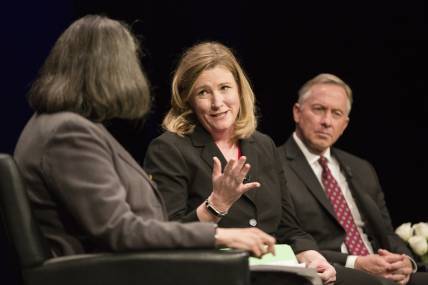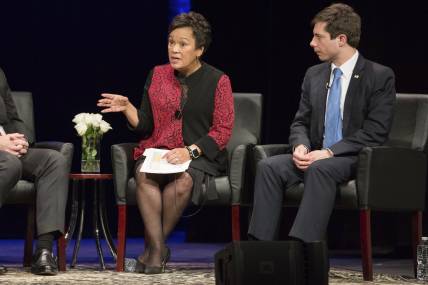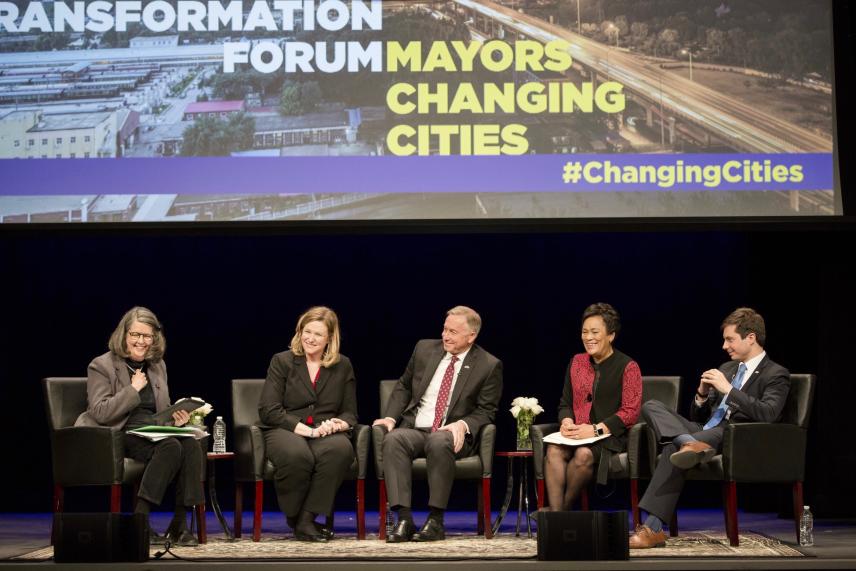At forum, mayors depict city government as locus of action
Mayors of four US cities say cities such as their own are making inroads against problems that Washington has often fumbled or ignored—from opiates to crime, and from assimilating immigrants to fixing roads, reducing energy consumption, and building back economic resiliency with the help of new technologies.
“Mayors are actually the most interesting people in politics, mostly because they have to get stuff done—they don’t have much time for real extremism, they have to be pretty pragmatic,” said Dayton, Ohio Mayor Nan Whaley.
Joining a lively panel discussion on April 18, Whaley drew a picture of proactive local-government responsiveness and effectiveness, along with John Giles of Mesa, Arizona; Pete Buttigieg of South Bend, Indiana; and Toni Harp of New Haven, Connecticut. The “Urban Transportation Forum: Mayors Changing Cities” was held at the Sheen Center for Thought and Culture. The sponsors were the US Conference of Mayors, the David Bohnett Foundation, and NYU Wagner.

Former New York Times editorial board member Eleanor Randolph, who is working on a book about former New York Mayor Michael Bloomberg, moderated the conversation and fielded questions from the audience in the room and others watching the livestream and using Twitter.
In Dayton, a severe opiate epidemic prompted Mayor Whaley to initiate a large harm-reduction program (for example, 125,000 clean needles were distributed just last year). The city of 145,000 people north of Cincinnati is among 400 cities suing pharmaceutical companies, and it placed a five cents-per-dose surcharge on prescription pain relievers to help cover the related public health costs.
Mesa, meanwhile, is a politically conservative border city with 485,000 residents, one-third of them recent immigrants. The long national debate over immigration, Mayor Giles said, threatens to force Mexican-Americans into the shadows. It has also had a negative effect on inter-border trade discussions, and could dampen the Census count, critical to future state aid levels for the fast-growing city.
Giles and other local officials in his city are redoubling efforts to rebuild trust among immigrants—“the people we shop with, go to church with, that our children go to school with."
“If you’re bringing in someone to talk about immigration, you might ask why it is not Jeff Flake, John McCain, or somebody who actually deals with the issue. I would suggest to you that just like opioids, where the issue is being dealt with is at the local level—far more effectively and in a more meaningful way—than at the national level,” the Mesa mayor said. “Folks don’t move to ‘America,’ they move to neighborhoods, they move to cities."

In New Haven, Mayor Harp said, she and other officials have honed community-based policing with new communication technologies and driven down homicides, nonfatal shooting victims, and shots fired—to dramatic effect. Separately, South Bend’s “Mayor Pete” is laying the groundwork for a 21st century city. Its once-resilient manufacturing base sapped by global economic shifts, the city now uses trash trucks with a robotic arm to empty garbage bins, a sensor system to manage “the world’s smartest sewers,” and iPhone cameras on utility trucks to scan the road for potholes.
It may be a sign of faith in local government that some voters have approved tax surcharges for defined purposes. One levy, in New Haven, pays for quality pre-K and road paving. Another one funds the completion of a light-rail line in downtown Mesa.
Watch a highlights reel below:
